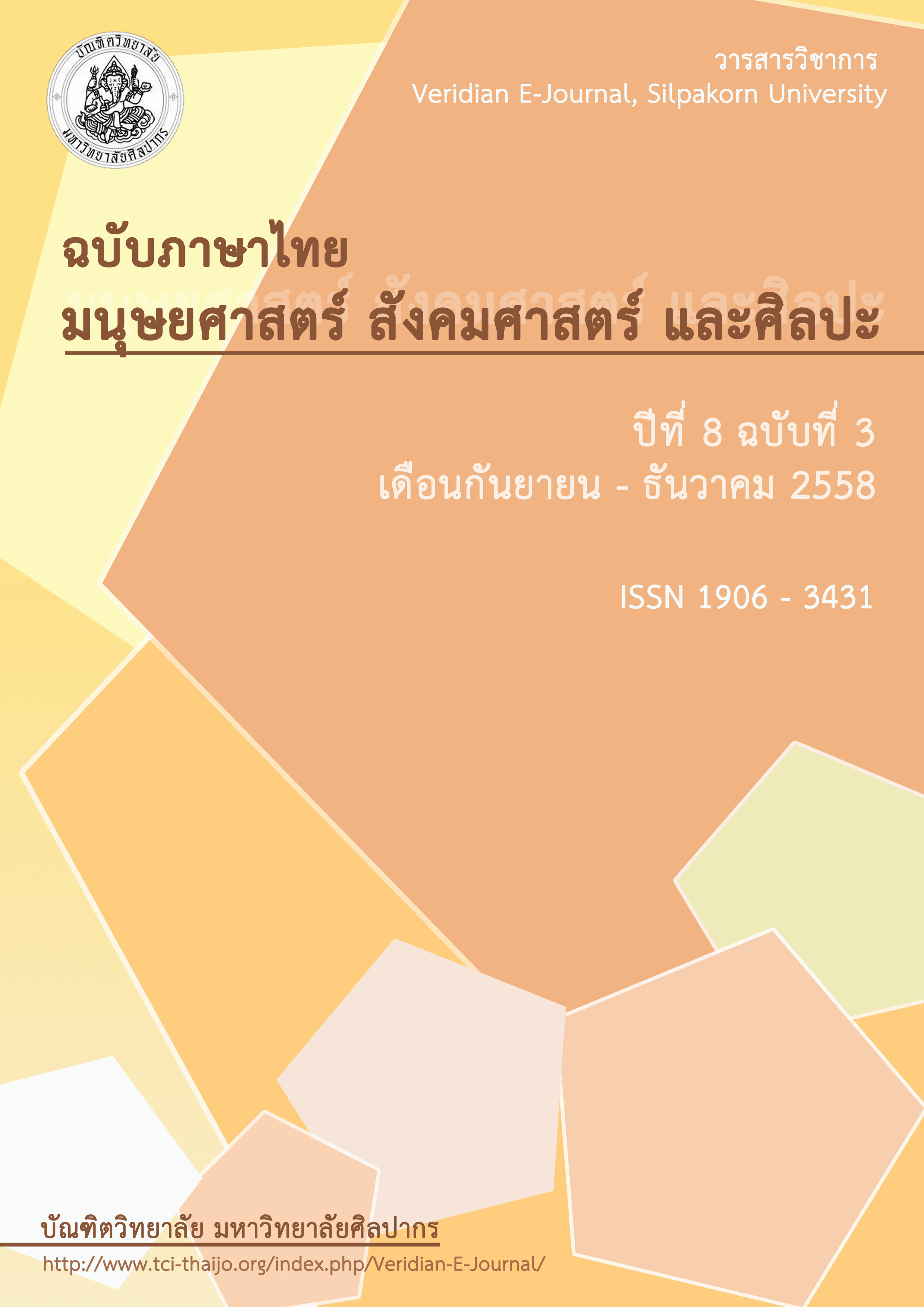การพัฒนารูปแบบและกลยุทธ์การตลาดการท่องเที่ยวเชิงรุกในแหล่งท่องเที่ยวที่มีบทเรียนจากความสูญเสีย อุบัติภัย และมรณภัย ในภูมิภาคตะวันตก ประเทศไทย
Main Article Content
Abstract
บทคัดย่อ
การวิจัยครั้งนี้มีวัตถุประสงค์เพื่อ 1) สำรวจแหล่งท่องเที่ยว 2) วิเคราะห์สภาพของแหล่งท่องเที่ยว 3) จัดทำกลยุทธ์เพื่อพัฒนาการตลาดการท่องเที่ยว และ 4) เพื่อสังเคราะห์นโยบาย/แนวทางในการวางกลยุทธ์การตลาดการท่องเที่ยวเชิงรุกในแหล่งท่องเที่ยวที่มีบทเรียนจากความสูญเสีย อุบัติภัย และมรณภัยในภูมิภาคตะวันตกด้วยการจัดประชุมเชิงนโยบายเป็นการวิจัยแบบผสมผสาน ระหว่างการวิจัยเชิงปริมาณและเชิงคุณภาพ โดยใช้เทคนิคการวิจัยอนาคต (Ethnographic Delphi Futures Research : EDFR) ด้วยการสัมภาษณ์เชิงลึกรอบที่ 1 และสอบถามความคิดเห็นในรอบที่ 2 กับผู้เชี่ยวชาญจำนวน 17 คน และพัฒนาเป็นแบบสอบถามเพื่อสอบถามนักท่องเที่ยวจำนวน 900 คน จากนั้นจึงนำข้อมูลที่ได้มาสังเคราะห์นโยบาย/แนวทางในการวางกลยุทธ์การตลาดการท่องเที่ยว
ผลการวิจัยพบว่า การสำรวจแหล่งท่องเที่ยวที่มีบทเรียนจากความสูญเสีย อุบัติภัย และมรณภัยในภูมิภาคตะวันตกซึ่งสำคัญทางประวัติศาสตร์ของการเกิดสงครามโลกครั้งที่ 2 จังหวัดกาญจนบุรีมีอนุสรณ์สถานหลายแห่งปรากฏให้เห็นเป็นหลักฐานที่แสดงถึงความสูญเสีย ผู้วิจัยจึงได้ใช้จังหวัดกาญจนบุรีเป็นพื้นที่สำคัญของการศึกษา สำหรับผลการวิเคราะห์สภาพของแหล่งท่องเที่ยวนั้นสถานการณ์ทางด้านเศรษฐกิจ การเมือง ภัยธรรมชาติ มีผลต่อการท่องเที่ยว อีกทั้งยังพบว่าแหล่งท่องเที่ยวที่มีบทเรียนจากความสูญเสีย อุบัติภัย และมรณภัยเป็นแหล่งท่องเที่ยวที่มีคุณค่าทางจิตใจ ที่ช่วยเตือนสติให้กับนักท่องเที่ยวและเป็นแหล่งท่องเที่ยวที่ให้มากกว่าการพักผ่อน รวมถึงการตลาดการท่องเที่ยวเชิงรุกไม่ควรมุ่งเน้นด้านของการลดราคาเพราะทำให้ได้กลุ่มนักท่องเที่ยวที่ไม่มีคุณภาพ ควรมุ่งเน้นคุณภาพมากกว่าปริมาณ และส่งเสริมการตลาดด้วยการจัดงานเทศกาลต่าง ๆ ผลการวิเคราะห์องค์ประกอบเชิงยืนยันอันดับสองของกลยุทธ์การตลาดการท่องเที่ยวเชิงรุก โมเดลสอดคล้องกับข้อมูลเชิงประจักษ์ โดยค่าน้ำหนักองค์ประกอบสูงสุด คือ ด้านสิ่งแวดล้อมทางกายภาพของแหล่งท่องเที่ยว รองลงมา คือ ด้านช่องทางการนำเสนอและการส่งเสริมการตลาด และด้านราคา ตามลำดับ นำกลยุทธ์ที่ได้ไปสังเคราะห์นโยบาย/แนวทางในการวางกลยุทธ์การตลาดการท่องเที่ยวด้วยการจัดประชุมเชิงนโยบาย ได้กลยุทธ์ทั้งหมด 5 กลยุทธ์ ได้แก่ 1) การส่งเสริมและพัฒนาการท่องเที่ยวในรูปแบบของการท่องเที่ยวที่มีบทเรียนจากความสูญเสีย อุบัติภัย และมรณภัย 2) การส่งเสริมและควบคุมคุณภาพของแหล่งท่องเที่ยว 3) การส่งเสริมและสนับสนุนการประชาสัมพันธ์แหล่งท่องเที่ยวโดยเน้นการถ่ายทอดเรื่องราว 4) การส่งเสริมและพัฒนาด้านสิ่งแวดล้อมทางกายภาพและจัดองค์ประกอบของแหล่งท่องเที่ยวเพื่อเอื้ออำนวยแก่กลุ่มนักท่องเที่ยวผู้สูงอายุและคนพิการ และ 5) การส่งเสริมให้มีการกำหนดกลยุทธ์เชิงรุกอย่างยั่งยืน
Abstract
The purposes of this study were 1) to explore the tourist attractions, 2) to analyze the conditions of the tourist attractions, 3) to find strategies for tourism marketing development, and 4) to synthesize policies/guideline for establishing proactive tourism marketing strategies in the tourist attractions with lessons from loss, accidents and danger of death in the western region, through the policy meeting. This research was an integrated research using both quantitative and qualitative methods. It also employed techniques of the future research, EDFR. 17 experts were first in-depth interviewed, and asked for their opinions. Their opinions were later used for developing the questionnaire, which were subsequently distributed to 900 tourists. Then, the data was synthesized to form policies/guidelines for establishing marketing strategies for tourism.
The research found that, according to the exploration, several tourist attractions with lessons from loss, accidents and danger of death in the western region are the historical areas of World War II, and are mostly located in Kanchanaburi Province. This is evidenced by several monuments indicating the loss. For these reasons, Kanchanaburi Province was selected as the main location of the study. Regarding the analysis of the conditions of the tourist attractions, it found that economic situation, political situation, and natural disasters affected tourism in this province. The researcher also found that the tourist attractions with lessons from loss, accidents and danger of death have spiritual values, which could remind the tourists of World War II, and be more than just relaxing places. Regarding the proactive tourism marketing, it should not focus on sale promotion because it would lead the low quality tourists to this area. On the other hand, they should focus on quality rather than quantity of the tourists, and promote the tourism by having events and festivals. According to the second confirmatory factor analysis of proactive tourism marketing strategies, the model corresponds with the empirical data. The maximum weights of elements are of the physical environment of the tourist attractions, presentation channels, sale promotion, and prices respectively. Finally, the strategies gained from the policy meeting were synthesized to form policies and marketing strategies for tourism. There were five strategies generated as follows: 1) promotion and tourism development for tourist attractions with lessons from loss, accidents and danger of death areas; 2) promotion and quality control of tourist; 3) promotion and support to public attractions focusing on presenting the story behind; 4) promotion and the physical environment development, and the composition of the attractions to be more appropriate for elderly and disabled tourists; and 5) promotion of the sustainable proactive strategies.
